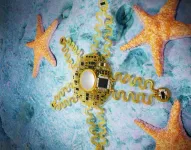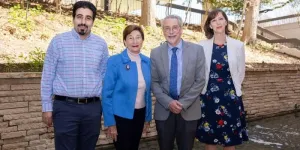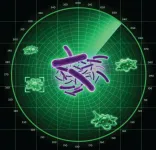(Press-News.org) When we move, it’s harder for existing wearable devices to accurately track our heart activity. But University of Missouri researchers found that a starfish’s five-arm shape helps solve this problem.
Inspired by how a starfish flips itself over — shrinking one of its arms and using the others in a coordinated motion to right itself — Sicheng Chen and Zheng Yan in Mizzou’s College of Engineering and collaborators have created a starfish-shaped wearable device that tracks heart health in real time.
Because the starfish-inspired device has multiple points touching the skin near the heart, it stays more stable than traditional wearables built as a single, unified structure, such as a smartwatch. This allows the device to collect clearer, more accurate heart data — even while someone is moving.
The device conveniently pairs with a smartphone app to provide the user with health insights and help detect potential heart problems.
“Similar to a starfish, our device has five arms, each equipped with sensors that simultaneously capture both electrical and mechanical heart activity,” Chen, a postdoctoral fellow and lead author, said. “Most current devices focus on capturing only one signal or require separate devices to track multiple signals at the same time. This allows us to provide a more complete picture of someone’s heart health.”
AI for smarter heart monitoring
The team developed an artificial intelligence-powered system that learned from a large collection of heart data, including signals from both healthy individuals and people with heart disease. Using smart technology, the system filters out movement-related disruptions and analyzes heart signals to determine if someone’s heart is healthy or showing signs of trouble. The findings are shown on the smartphone app.
This AI-based approach correctly identifies heart conditions more than 90% of the time. Because the device has Bluetooth capability, doctors can review the data remotely, making it a convenient option for at-home monitoring between medical visits.
"This is also a benefit over traditional clinical heart tests such as the Doppler ultrasound, which usually requires patients to stay still to get accurate results," Chen said.
Designed for comfort and long-term use
The team is also improving the long-term wearability of these devices.
“A big challenge with wearable devices is that they can cause skin irritation when worn for long periods,” Yan, an associate professor in Mizzou’s College of Engineering, said.
To address this, Yan’s team is working on making the device more comfortable and skin friendly. Right now, the device sticks to the skin using a special gel, but future versions will use a breathable, skin-friendly material for more comfort. Yan’s team has been improving this material for the past few years.
The starfish-inspired device can also charge wirelessly while still being worn, ensuring continuous use without needing to remove it for charging.
While still in early development, the starfish-inspired innovation brings together nature, engineering and AI in a way that could change how we manage heart health — making it easier and more reliable for people to track their heart activity anytime, anywhere.
“Starfish-inspired wearable bioelectronic systems for physiological signal monitoring during motion and real-time heart disease diagnosis,” was published in the journal Science Advances. Other co-authors are Qunle Ouyang, Xuanbo Miao Zehua Chen and Ganggang Zhao at Mizzou.
END
Scientists unveil starfish-inspired wearable tech for heart monitoring
Designed by University of Missouri researchers, the device includes AI technology to detect potential heart problems with over 90% accuracy, making it a promising tool for at-home monitoring
2025-04-02
ELSE PRESS RELEASES FROM THIS DATE:
Footprints reveal prehistoric Scottish lagoons were stomping grounds for giant Jurassic dinosaurs
2025-04-02
Jurassic dinosaurs milled about ancient Scottish lagoons, leaving up to 131 footprints at a newly discovered stomping ground on the Isle of Skye in Scotland, according to a study published April 2, 2025 in the open-access journal PLOS One by Tone Blakesley of the University of Edinburgh, Scotland and colleagues.
In the rocks of the Isle of Skye, dinosaur footprints are abundant, providing insights into dinosaur distribution and behavior during an important time in their evolution. The footprints were left in the rippled sands of an ancient subtropical lagoon, dating back to the Middle Jurassic ...
AI effectively predicts dementia risk in American Indian/Alaska Native elders
2025-04-02
Irvine, Calif., April 2, 2025 — Machine learning algorithms utilizing electronic health records can effectively predict two-year dementia risk among American Indian/Alaska Native adults aged 65 years and older, according to a University of California, Irvine-led study. The findings provide a valuable framework for other healthcare systems, particularly those serving resource-limited populations.
The computer modeling results also found several new predictors for dementia diagnosis that were identified consistently across different machine-learning models. Findings are published in the Lancet Regional Health – Americas. The National Institutes ...
First guideline on newborn screening for cystic fibrosis calls for changes in practice to improve outcomes
2025-04-02
The United States Cystic Fibrosis Foundation released the first guideline on newborn screening for cystic fibrosis (CF), in order to improve timely detection of CF in infants from all racial and ethnic backgrounds. The new guideline, based on systematic literature reviews and published in the International Journal of Neonatal Screening, reflects rigorous scientific investigation and perspectives from parents, CF specialists, public health representatives, primary care providers and genetic counselors.
CF is a genetic disorder that causes problems with digestion and breathing. Currently, newborns in every state are screened for ...
Existing international law can help secure peace and security in outer space, study shows
2025-04-02
World leaders should look to existing international law on the use of force to address the threat of space becoming ever more militarized, a new study shows.
Space has the potential to be a source and place of armed conflict and regulating military activities in space is of pressing international concern.
Tests of anti-satellite (ASAT) weapons have fuelled fears of warfare in space. Resulting space debris from ASAT weapon threatens other satellites in orbit, many of which underpin the operation of human societies and the functioning of global economies.
Conflict ...
Pinning down the process of West Nile virus transmission
2025-04-02
COLUMBUS, Ohio – Mosquitoes have been transmitting the West Nile virus to humans in the United States for over 25 years, but we still don’t know precisely how the virus cycles through these pests and the other animals they bite.
A federally funded project aims to help pin down the process by using mathematical models to analyze how factors like temperature, light pollution, and bird and mosquito abundance affect West Nile virus transmission. The ultimate goal is to advise health departments of the best time of year to kill the bugs.
“I’m hopeful that what we will uncover in this grant will help us to better understand what’s driving West Nile virus transmission, ...
UTA-backed research tackles health challenges across ages
2025-04-02
Genevieve Graaf spent years as a mental health social worker specializing in children and youth with complex behavioral health needs. Many had to travel to other states or hundreds of miles from family to access adequate medical care. Drawing on her experience, Dr. Graaf, an assistant professor of social work at The University of Texas at Arlington, has continuously sought ways to improve community-based support programs and ease the burden on families.
She will build on that work with her latest research through UT Arlington’s Center ...
In pancreatic cancer, a race against time
2025-04-02
Pancreatic cancer is projected to become the second-deadliest cancer by 2030. By the time it’s diagnosed, it’s often difficult to treat. So, for both individual patients and the general population, fighting pancreatic cancer can feel like a race against time. Cold Spring Harbor Laboratory (CSHL) Professor and Cancer Center Director David Tuveson offers a telling analogy:
“We all have moles on our skin. Most of your moles are fine. But some of your moles you have a dermatologist looking at to make sure it’s always fine. They ...
Targeting FGFR2 may prevent or delay some KRAS-mutated pancreatic cancers
2025-04-02
Bottom Line: Precancerous pancreatic lesions and some pancreatic ductal adenocarcinoma (PDAC) tumors harboring KRAS mutations had higher-than-normal expression of the FGFR2 protein, and FGFR2 inactivation delayed KRAS-mutated PDAC development in mice.
Journal in Which the Study was Published: Cancer Research, a journal of the American Association for Cancer Research
Author: Claudia Tonelli, PhD, a research investigator in the laboratory of AACR Past President David A. Tuveson, MD, PhD, FAACR, at Cold Spring Harbor Laboratory
Background: PDAC is the most common ...
Melodies of musical ‘starquakes’ shed new light on how our galaxy formed
2025-04-02
They say music is the universal language of humankind, but some stars in our galaxy exhibit their own rhythm, offering fresh clues into how they and our galaxy evolved over time.
According to an international team of researchers, including scientists from The Australian National University (ANU) and UNSW Sydney, some stars exhibit fluctuations in their brightness over time, which are caused by continuous ‘starquakes’.
These fluctuations can be translated into frequencies, which can be used to determine a star’s age and other properties ...
Protective radar for bacteria
2025-04-02
Investigation how microorganisms communicate enhances our understanding of the complex ecological interactions that shape our environment – a major focus of the Cluster of Excellence “Balance of the Microverse”. A research team of the Cluster at the Leibniz Institute for Natural Product Research and Infection Biology - Hans Knöll Institute (Leibniz-HKI) and the Friedrich Schiller University, Jena has studied the interaction between amoebae, bacteria, and plants. Researchers from the ...
LAST 30 PRESS RELEASES:
Making lighter work of calculating fluid and heat flow
Normalizing blood sugar can halve heart attack risk
Lowering blood sugar cuts heart attack risk in people with prediabetes
Study links genetic variants to risk of blinding eye disease in premature infants
Non-opioid ‘pain sponge’ therapy halts cartilage degeneration and relieves chronic pain
AI can pick up cultural values by mimicking how kids learn
China’s ecological redlines offer fast track to 30 x 30 global conservation goal
Invisible indoor threats: emerging household contaminants and their growing risks to human health
Adding antibody treatment to chemo boosts outcomes for children with rare cancer
Germline pathogenic variants among women without a history of breast cancer
Tanning beds triple melanoma risk, potentially causing broad DNA damage
Unique bond identified as key to viral infection speed
Indoor tanning makes youthful skin much older on a genetic level
Mouse model sheds new light on the causes and potential solutions to human GI problems linked to muscular dystrophy
The Journal of Nuclear Medicine ahead-of-print tip sheet: December 12, 2025
Smarter tools for peering into the microscopic world
Applications open for funding to conduct research in the Kinsey Institute archives
Global measure underestimates the severity of food insecurity
Child survivors of critical illness are missing out on timely follow up care
Risk-based vs annual breast cancer screening / the WISDOM randomized clinical trial
University of Toronto launches Electric Vehicle Innovation Ontario to accelerate advanced EV technologies and build Canada’s innovation advantage
Early relapse predicts poor outcomes in aggressive blood cancer
American College of Lifestyle Medicine applauds two CMS models aligned with lifestyle medicine practice and reimbursement
Clinical trial finds cannabis use not a barrier to quitting nicotine vaping
Supplemental nutrition assistance program policies and food insecurity
Switching immune cells to “night mode” could limit damage after a heart attack, study suggests
URI-based Global RIghts Project report spotlights continued troubling trends in worldwide inhumane treatment
Neutrophils are less aggressive at night, explaining why nighttime heart attacks cause less damage than daytime events
Menopausal hormone therapy may not pose breast cancer risk for women with BRCA mutations
Mobile health tool may improve quality of life for adolescent and young adult breast cancer survivors
[Press-News.org] Scientists unveil starfish-inspired wearable tech for heart monitoringDesigned by University of Missouri researchers, the device includes AI technology to detect potential heart problems with over 90% accuracy, making it a promising tool for at-home monitoring






